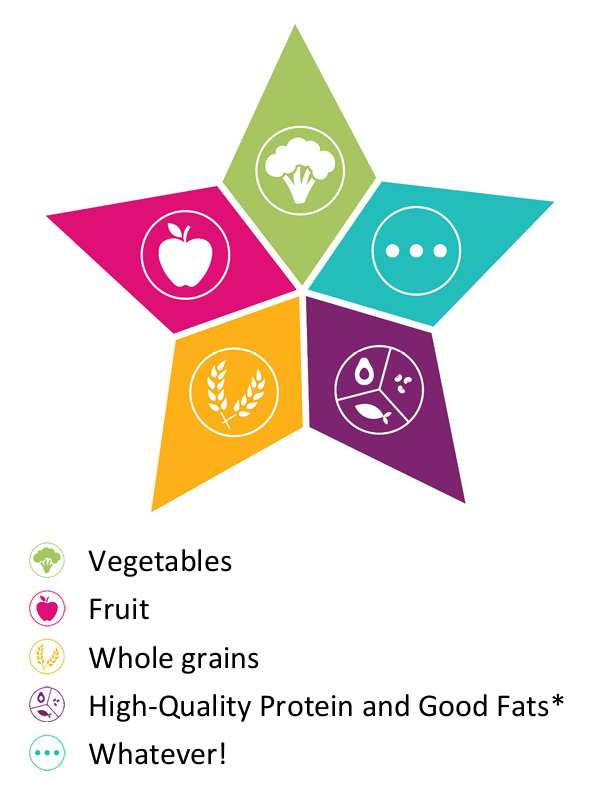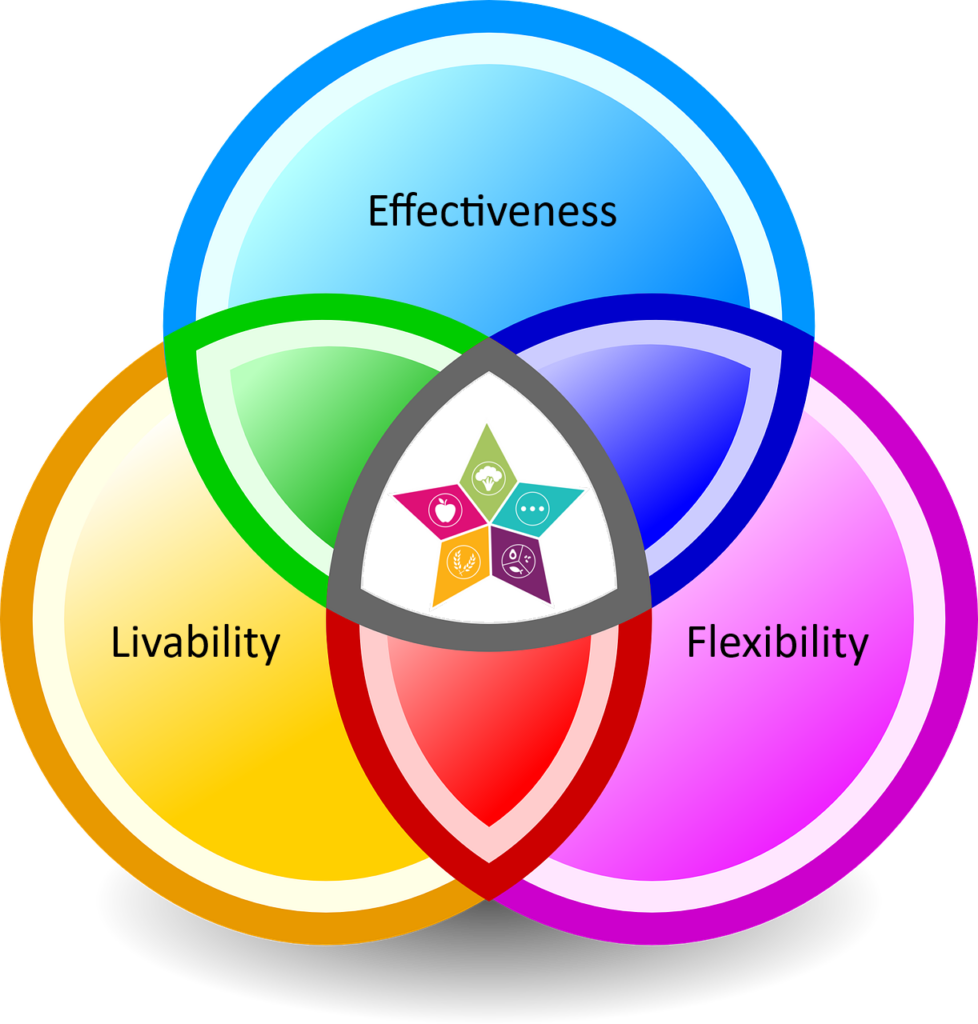
As introduced on our home page, the Nutrition Star represents Project Simplify Health’s healthy dietary recommendations. We’ll discuss it in more detail here.
Since the Nutrition Star is essentially made up of five diamonds, we call the four healthy diamonds “4-Diamond (4◊) Foods.” The percentage of the calories in something you eat that comes from 4◊Foods is called the “4◊Score™.” For example, any food product or meal that is made up completely (100%) of 4◊Foods (i.e., contains no “Whatever!” – see below) has a 4◊Score = 100.
However, although it’s always wise to get a good variety, you do not have to obsess about getting 20% from each diamond of the 4◊Foods. We believe in “The 4:1 Rule” – that as long as you get >80% of your calories from 4◊Foods, you can play with the other <20% (Whatever!), the latter being overwhelmed (neutralized) by the sheer micronutrient/phytochemical power of the former. And the higher you go above 80%, the better your health and weight loss success!
Imagine what would happen to the health of every individual in the nation (it would improve!) if packaged product manufacturers and restaurants began to list the 4◊Scores of all of their products and menu items – or at least the ones with a 4◊Score >80! It would sure make it easier to develop healthier eating habits and better manage one’s health and weight long-term!
In fact, not only do we warmly invite restaurants to create a separate 4◊Menu, but we are also developing a 4◊Score database of packaged products. When you look at the latter, you’ll see that it is quite small, and very much a work in progress. Since Project Simplify Health is a non-profit organization, we are counting on the public (“crowd-based” effort, boots-on-the-ground) to help build it. Because of that, we cannot guarantee its accuracy. Whether you wish to contribute or to correct, please contact us.
Nutrition Star Details
The Vegetables, Fruit, and Whole grains sections:
ANY type of whole (non-processed, meaning all the original nutrients and fiber are preserved) vegetable, fruit, or grain can be used to fill their respective “diamonds.” In other words, it does not matter what kind of plant you eat within each of the exclusively plant categories – as long you use the whole plant and it is prepared healthily. For example, potatoes are perfectly healthy as long as they are not deep-fried (which is how 50% of all potatoes are consumed in America) or loaded with lots of “Whatever!” (see below).
The High Quality Protein and Good Fats section includes:
- Legumes (e.g., beans, peas, and lentils)
- Nuts and seeds
- Avocados
- Olives
- Coconut
- Fatty seafood like salmon, tuna, and trout
- Up to 6 ounces of lean meat OR 2 eggs/day (or 3 ounces lean meat AND 1 egg/day)
“Lean meat” in this case can be defined as having no visible fat, but specifically:
- Beef or ham/pork with <10% fat (10 or fewer grams of fat per 100 g or 3.5 oz) and no visible fat
- Chicken or turkey breast that is skinless and has no visible fat
- Non-fatty seafood (including shrimp, crab, lobster, oysters)
- Eggs (not technically meat, but they fall into this category)
The Whatever! section includes all other foods fall:
- A category we call plant waste (plant products with all/almost all of the nutritious components and fiber processed out, e.g., high-fructose corn syrup, sugar, white flour, oil, alcohol)
- Dairy (milk, yogurt, cheese, sour cream, cream, and butter) – on a personal level, you may choose to include (only) low-fat yogurt and milk in the High Quality Protein and Good Fats section; however, on an industry level, for our purposes, all dairy must be placed in the Whatever! section, and be absent from all packaged products and menu items with a 4◊Score = 100.
- Processed meats, meat with visible fat, or either lean meat above 6 ounces/day or 2 eggs/day (or above 3 ounces lean meat and 1 egg/day)
We have assigned each of the above foods to the Whatever! section because we feel strongly that they are counterproductive to health and/or weight management. Why? Yes, we fully understand that some are worse than others, but it’s because they are 1) lower in (or have no) nutrient density, 2) high in bad fats and/or caloric density, 3) more addicting (and therefore cause you to crave and eat more), and/or 4) consist of consumables whose potential harms outweigh the potential benefits. And this leads us to a critical concept:
Hidden Calories and Inflammation
Unless you make food yourself (or watch it being made), it is rarely “WYSIWYG” (a term you’ll know if you’re old enough, used in computing: What You See Is What You Get). Despite nutrition labels and lists of ingredients, you have no idea how much certain types of plant waste (e.g., sugar and oil) and dairy (e.g., milk, cream, and butter) are truly present, as they are often or almost always invisible to the naked eye – especially in restaurants, where they only list the ingredients you see. Indeed, what’s hidden or unclear are among the most addicting, inflammatory (causing disease), and/or obesogenic (causing obesity) parts of the meal!
Important points to remember:
- To achieve a 4◊Score of 100, foods are sweetened with whole plants, such as Medjool dates, bananas, raisins, etc. (artificial sweeteners are likely to be less healthy than whole plants but less harmful than sugar; however, you get to make that call).
- Foods can be made creamier with things like puréed cashews (especially great for salad dressings and even plant-based sour cream!) and potatoes.
- Whole herbs, minerals, spices and low caloric plant products (e.g., plant-based “milk” – excluding coconut milk) are considered under 4◊Foods and can be used at will (the main exception being moderating salt in the salt-sensitive)
- Use spray butter instead of butter and margarine.
- White rice is considered to have a 4◊Score of 50, because not all the nutrients are processed (milled) out.
- Oil is devoid of water, fiber, and almost all micronutrients, and is nature’s most efficient way to store fuel (i.e., increase the risk of weight gain) – therefore any type causes more harm than good. Don’t consume olive oil – eat the whole olive. Find ways to cook without it, e.g., grill, steam, bake, boil, broil, roast, sous vide, other. You can also sauté using non-stick spray and/or vegetable broth.
- The internet is full of ideas and recipes that are oil- and/or sugar-free.
What the Nutrition Star turns out to be is an 80+% healthily-prepared plant- and lean protein/fatty seafood-based diet. We believe it provides the magical intersection between what’s Effective, Livable, and Flexible (“The Magic ELF”) – and, it is adaptable to about any eating preference! Which is why, again, we invite individuals and industry alike to unite behind a single banner – Project Simplify Health!
